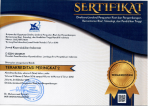DAMPAK INVESTASI TERHADAP KETIMPANGAN KESEMPATAN KERJA REGIONAL DI INDONESIA
Abstract
Keywords: Nuaulu; Ethnicity; Social Policy; Social Exclusion
Keywords
Full Text:
PDFReferences
Anderson, B. (1991). Imagined Communities: Reflections on the Origin and Spread of Nationalism, (Revised edition), Verso, London; New York.
Asian Development Bank. (1998). The Bank's Policy on Indigenous People, retrieved from www.adb.org/document/reports/ 31 May 2005.
Asian Development Bank. (2002). Indigenous Peoples/ Ethnic Minorities and Poverty Reduction, Indonesia, retrieved from www.adb.org/document/reports/2 November 2005.
Barnes, R.H. (1995). Being Indigenous in Eastern Indonesia. Association for Asian Studies, Ann Arbor. Biro Pusat Statistik. 199o-1997. Maluku Dalam Angka, Kantor Statistik Provinsi Maluku.
Biro Pusat Statistik. (2002). Maluku Tengah Dalam Angka. Kantor Statistik Propinsi Maluku. Biro Pusat Statistik. 2003. Maluku Tengah Dalam Angka, Kantor Statistik Propinsi Maluku.
Brauns, L. W. (1989). Pusaka Huinelo. Verborgen Erfenolton.
Bolton, R.A. (1990). "A Preliminary Description of Nuaulu Phonology and Grammar", Thesis. University of Texas,. Bell and Howell, Michigan.
Demography Health Survey. (2003). Country Statistics of Indonesia, retrieved from http:// www.measuredhs.com/pubs/search_results.cfm 1 July 2005.
Ellen, R.F. (1977). "Resources and commodity: Problems in the Analysis of the Social Relations ofNuauluLand Use", Journal Anthropological Research, vol. 33 no.l, the University of New Mexico, Albuquerque, pp. 5o-72. crossref
Ellen, R.F. (1978). Nuaulu Settlement: an Approach to the Environmental Relations of an Eastern Indonesian Community. Koninklijk Institute voor Taal, Land en Volkenkunde (KITLV), Leiden.
Frankenberg, E. (1992). "Infant and Early Childhood Mortality in Indonesia: the Impact of Access to Health facilities and Other Community Characteristics on mortality". Thesis.
Bell and Howell, Michigan. Hidayati, D. (1999). Population and Environment Issues in Maluku: the Case of Western and Northern Seram. Jakarta: Indonesian Institute of Sciences.
Indonesia Demography and Health Surveys (Country Report 2002-2003). (2003). Ministry of Health, Jakarta, Indonesia; retrieved from www.measuredhs.com 1 July 2005.
Indonesia Demography and Health Surveys (Country Report 1 997). (1998). Ministry of Health, Jakarta, Indonesia, retrieved from www.measuredhs.com 1 July 2005.
IUCN Interconnnission Task Force on Indigenous Peoples. (1997). "Who is indigenous peoples". Chapter I in IUCN Intercommission Task Force on Indigenous Peoples. Indigenous Peoples and Sustainability: Cases and Actions. Utrecht: International Books.
Kin, F. (2000). Social and Behavioural Aspects of Malaria Control: a Study Among the Murut of Sabah. Borneo Research Council, Philips USA.
Lautenbach, H. (1999). "Demography Survey Research in Irian Jaya, Population Dynamic in the TeminabuanArea of the Bird's Head Peninsula oflrian Jaya Indonesia." Thesis. Publication, Amsterdam.
Mahy, M. (2003). Child Mortality in the Developing World. HDS Comparative Reports, no. 4, ORC Macro, Calverton, Maryland USA.
Marhaeni, A. A. Istri. (1993). Analisa Perkembangan Kependudukan Menurut Sensus Penduduk 1990: Dinamika Mortalitas Maluku -Irian Jaya. Yogyakarta: Pusat Penelitian Kependudukan, Universitas Gadjah Mada.
Masset, E and Howard White. (2003). Infant and Child Mortality in Andhra Pradesh: Analysing Changes Over 1ime and Between States. Institute of Development Studies University of Sussex. Ministry of Health. 1993.
Posyandu and Primary Health Care in Indonesia. Jakarta: Department of Health Affairs. Ministry of Social Affairs. (2003a). Decree of Director General of Social Empowerment, no. 020.AIPSIKPTSNI/2002 concerning the implementation guidelines of Traditional Remote Communities, Directorate of Traditional Remote Community Empowerment, Ministry of Social Affairs, Indonesia.
Ministry of Social Affairs. (2003b). The standardisation guidelines of counselling and evaluation on traditional remote communities empowerment policy, Directorate of Traditional Remote Community Empowerment, Ministry of Social Affairs, Indonesia.
Muhidin, S. (2002). The Population of Indonesia: Regional demographic scenarios using a multiregional method and multiple data sources, Rozenberg, Amsterdam.
Nuryadin, La Ode T. (2004). KAT: Riwayatmu Nanti! Pemberdayaan yang Terdistorsi; KAT: sebuah Fenomena, article in KAT-CENTER, retrieved from http://www.katcenter.info 2 November 2005
Sen, A. (1999). Development as Freedom, Oxford: Oxford University Press.
Shryock, H. S, JacobS. Siegel and Associates. (1976). "Racial and Ethnic Composition", Chapter 9 in Studies in Population - The Methods and Materials of Demography, Academic Press, Inc.
Shryock, H. S., JacobS. Siegel and Associates. (1976). "Mortality", Chapter 14 in Studies in population - The Methods and materials of demography, Academic Press, Inc.
Stavenhagen, R. (1998). "Indigenous Peoples: Emerging International Actors". In Crawford Young ( ed), Ethnic Diversity and Public Policy, a Comparative Inquiry. UNRISD, Antony Rowe Ltd, Chippenham, Wiltshire, pp. 133-152. crossref
Swasono, M.F. (1998). Kehamilan, Kelahiran, Perawatan lbu dan Bayi Dalam Konteks Budaya. Jakarta: University of Indonesia.
Taken, W., W.B. Snellen, J.P. Verhave, B.GJ. Knols and S. Atmosoedjono. (1990). Environmental Measures for Malaria Control in Indonesia - an Historical Review on Species Sanitation. Agricultural University, Wageningen, The Netherlands.
United Nations. (1986). "Determinants of Mortality Change and Differentials in Developing Countries: the Five-Country Case Study Project". Populations Studies, no. 94, United Nation Publications.
van Klinken, G. (2003). "Etbnicity in Indonesia". In Colin Mackerras (Ed) Ethnicity in Asia, Routledge Curzon, pp. 64-87.
Woldemicael, G. (1999). Infant and Child Mortality in Eritra: Levels, Trends and Determinants. Demography Unit Stockholm University, Akademitryck AB, Edsbruk.
DOI: https://doi.org/10.14203/jki.v2i1.138
Copyright (c) 2007 Jurnal Kependudukan Indonesia

This work is licensed under a Creative Commons Attribution-NonCommercial-ShareAlike 4.0 International License.
-----------------------------------------------------------------------------------------------------------------------------
Research Center for Population, Indonesian Institute of Sciences
Widya Graha Building, 7th and 10th floors
Jl. Jenderal Gatot Subroto 10 Jakarta Selatan, Telp (021) 5221687
Website: http:/kependudukan.lipi.go.id;
E-Journal: http://ejurnal.kependudukan.lipi.go.id
Pustaka: http://pustaka.kependudukan.lipi.go.id
-----------------------------------------------------------------------------------------------------------------------------








